Reflection on Mary MacKillop
February 8, 2021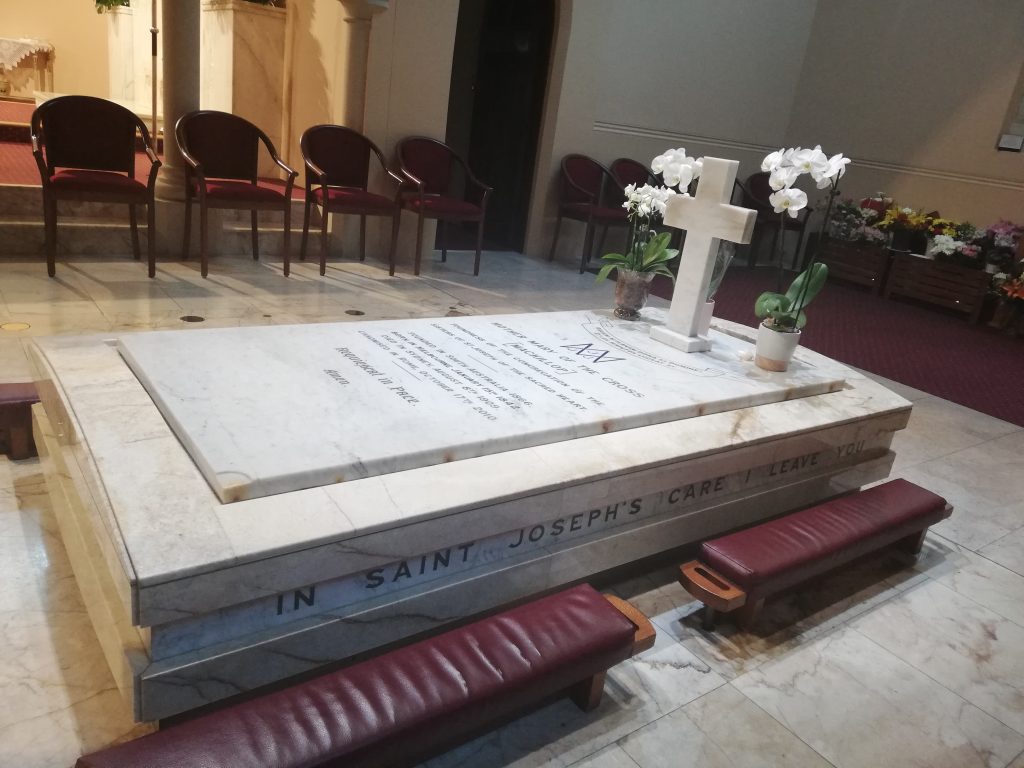
In his Apostolic Letter With a Father’s Heart (Patris Corde) Pope Francis has proclaimed this year as the Year of St Joseph.
In writing, Francis describes St Joseph “as a beloved father, a tender and loving father, an obedient father, an accepting father, a father who is creatively courageous, a working father, a father in the shadows.”
Mary MacKillop must be rejoicing and acclaiming Pope Francis from her Godly surroundings on such a profoundly wise and appropriate declaration of our patron St Joseph!
The Racetrack’s Appeal
January 19, 2021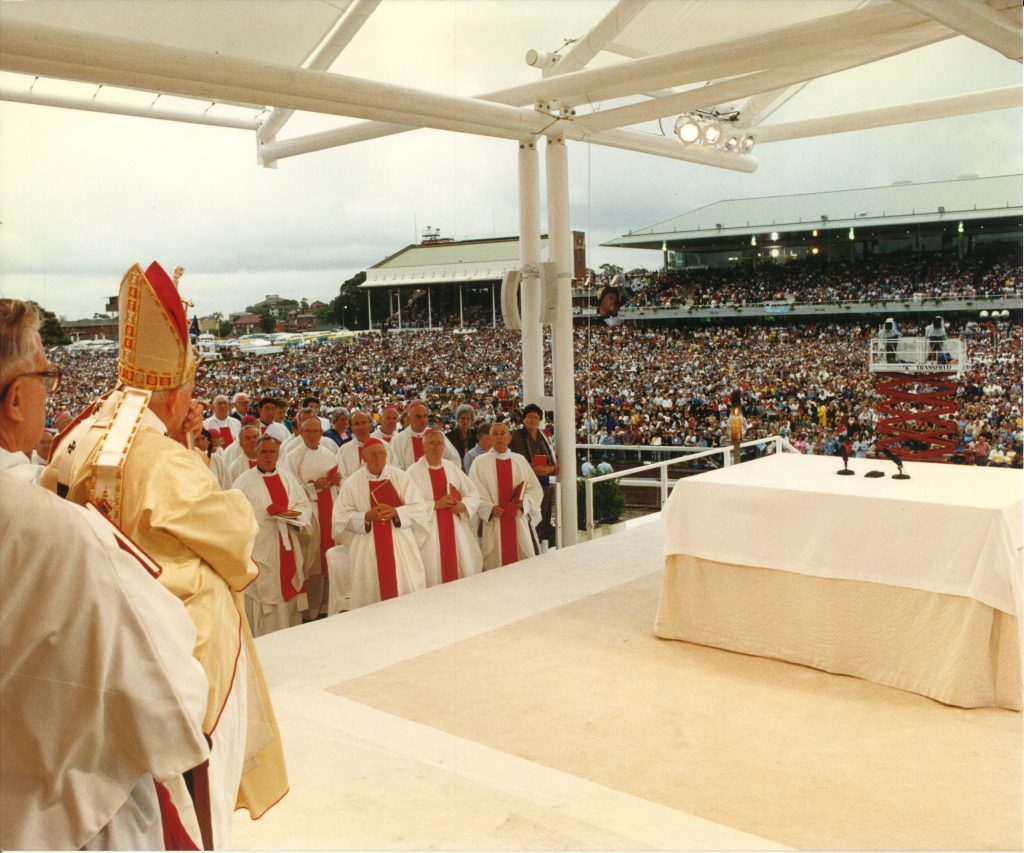
Mary’s Beatification Mass Remembered.
Mary’s Beatification stirred the hearts and minds of all Australians. As a first for this nation, everyone had to learn what beatification was all about. At the time I remember hearing of people talking about Mary’s beautification. That sounded so funny at the time and highlighted the need to understand further what beatification was all about. While there was no need for any further beautification of Mary, beatification gave her the title of Blessed and named and claimed her as a holy one, whose living of the Gospel, provided great inspiration and hope for all Australians and beyond.
Mary MacKillop’s Birthday (15 January)
January 15, 2021Beginnings are important. They often act as a prologue, as it were, to the meaning of what follows.
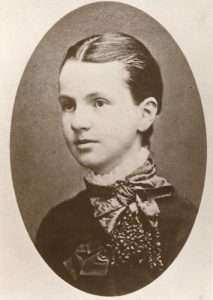
Over past weeks we have pondered the meaning of Jesus’ life as described in the infancy narratives of Matthew and Luke. Right from the beginning, we are told, the birth of Jesus would demonstrate the Good News he would be for the poor; his coming would bring light to the nations and show the world the true path to peace. In the midst of suffering and hardship, the message that God is present with us enables us to find hope, no matter how dense the darkness.
So what of the birth of Mary MacKillop? This child who would prove to be pioneer in so many aspects of Australian religious and social history was born of migrant parents in the pioneer settlement of Melbourne on 15 January 1842. Her father, Alexander, had arrived from Scotland barely four years before, and had married another migrant, Flora McDonald, on 14 July 1840. At first, the family’s prospects looked good, but through a series of unfortunate happenings, Alexander soon lost his favourable social and financial standing, ‘due to a combination of his character, his lack of business sense and the fact that there were a lot of smarter people around.’[1] Nevertheless, Alexander was an intelligent, educated man, passionate for the rights of all, no matter what their background. It can be attributed to his foundational influence that his daughter, Mary, would later be instrumental in assuring in Australia and beyond the right of every child to an education. Her belief in a classless society would bring her grief, as it did her father, yet since it was based on an understanding of the God-given dignity of every human being, it was integrated into her whole way of life, her growth into sanctity.
Reflection on Mary MacKillop
December 8, 2020The Queensland Sisters of Saint Joseph were honoured to have Bishop E. J. Cuskelly as chaplain.
Frank Fletcher MSC in one of his memorial lectures likens Cuskelly’s spirituality to the description by E.E. Cummings:
Bishop Cuskelly shared his spirituality with Mary MacKillop’s and fostered her saintliness in his preaching and in his writings.[1]
Mary MacKillop is the saint of reconciliation whom we all need. She excused and she forgave. Of a priest who had been the main cause of her excommunication and had told lies about her. She wrote:
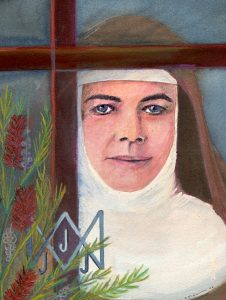
To some of the Sisters who had spoken untruths about her, she wrote: “I excuse and with all a mother’s heart I forgive. And I freely forgive and wish to forget, so I do entreat you my dearly loved ones, to forgive from your heart any sister that has pained you.” [2]
Cuskelly recounts a story from Mary’s teaching days at Portland where a school headmaster, Mr Cusack, came to the school. When the Inspector arrived to examine the classes, Mr Cusack poached the children from Mary’s and Annie’s classes and took credit for the well taught pupils while they were given the poorer students. By cheating, he prompted his class by giving answers behind the Inspector’s back. Mary’s father spoke loudly and strongly about these actions. Annie lost her job and Mary was blamed for what went wrong. All this took its toll on Mary. She was deeply hurt, was distrusted by some and it caused upset to the MacKillop family. Eventually Cusack lost his job and attributed blame to Mary. Again Mary was reconciliatory.
Mary Cresp’s sequel to this story demonstrates the depths of Mary’s forgiving heart and saintly life. When we read that Mary recognized an old acquaintance at Circular Quay, we are immediately engaged. However, when we discover that this dirty, alcoholic tramp was the schoolmaster whose cheating had led to Mary’s disgrace at Portland, the Gospel begins to unfold. For this man Mary sold her watch so that she could get him a suit of clothes and care. [3]
 Let us reflect:
Let us reflect:
- Mary MacKillop models a forgiving heart. Consider times you have been wrongly blamed, deeply embarrassed or hurt, or even lost friends or family because of a situation.
- What small gesture could heal a long time hurt?
- Often we suffer because of pride and an expectation on the ‘other’ to make the first move. In what small way can we emulate Mary?
Michele Shipperley rsj
Footnotes:
[1] Mary MacKillop – A Spiritual Model for All
[2] Ibid.
[3] Mary Cresp, Reflections on Beatification, 25 Jan 1995
In the Footsteps of Mary MacKillop
November 8, 2020For the past twenty-five years, the Sisters of Saint Joseph have invited people to participate in the ‘Australian National Pilgrimage: In the Footsteps of Mary MacKillop.’
Unfortunately they have not been able to offer this opportunity of journeying with Mary in 2020.
Mary reminds us that ‘We are but travellers here.’
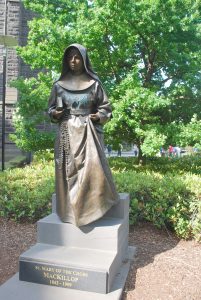
You are invited to read and reflect on the following article ‘St Mary MacKillop – The Pilgrim’, written by Mary Cresp rsj.
The theme of journey was never far from the thoughts of Mary MacKillop.
As the words printed around her tomb remind us, she saw life as a journey. Remember we are but travellers here, she said. The many journeys that made up her life were both actual and metaphorical. Perhaps one expressed the other. From the time Mary was a little girl moving from one relative to another to when, in her last years, she was confined to a wheelchair, she was still ‘on her way’ towards that intimacy with God that ‘heaven’ represents.
When we go on a pilgrimage, we have to ‘let go’ of the certainties of life as it has been. We have to be open to receive the unknown and to receive the hospitality of others. Mary MacKillop’s attitude to God was like that. She learnt to be open at all times to what God wanted to do in her – she called that ‘doing God’s Will’. It meant letting go of personal hopes and ambitions, entrusting them into God’s hands. With gratitude she accepted the hospitality of others – when she was vulnerable, as she was during her journeys overseas. Our journey, too, has involved a letting go that will continue into old age and finally at death, when we enter into our final journey. During our Mary MacKillop pilgrimage we can join with her as, following her footsteps, we open ourselves to receive with gratitude God’s bounty in the hospitality of others.
A pilgrim has to ‘live into the now’. Because we can’t guarantee what lies around the corner, we have to learn what it means to live life fully where we are. Don’t be troubled about the future of the Institute, Mary MacKillop said, I am not. He whose work it is will take care of it. The Gospel of her feast proclaims Jesus’ words: Do not worry about tomorrow … today’s trouble is enough for today. (Mt. 6:34) Being alive to the moment meant that Mary was alert to the needs of her time. The aspect of God’s love characteristic of the charism given her was compassion – God feeling with us in the situation of our lives. Being with another is part of being a pilgrim.
Even if travelling alone, a pilgrim is never independent. We meet others along the way, we depend on them for food and lodging, we are invited to listen to the stories of the people we encounter. In this way we learn of a God who is ever present and who, Mary knew, walks with us each step of the journey…
Reflection on Mary MacKillop
Mary MacKillop could be remembered as a great journalist in her day.
Mary MacKillop’s journals and her letters have left us a plethora of stories of herself, her family, and the early days of the colony when she was such a vital part of the community. She created images of her journeys and her compassion for the poor; we learn of her belief in the importance of education; we imbibe her sense of mission and deep spirituality.
Mary’s diaries give us a great insight into the highs and lows of her life. We learn of her illness, her loneliness, her courage and zeal. From one of her diary entries we feel her pain and sadness as she expresses her emotions in these words:
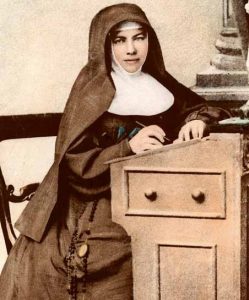 Mary and the early sisters used to beg to make ends meet. Throughout these stories of seeking out food, we see her compassion for the sick and the downtrodden. She shared the little they had and sometimes gave her own meal to someone in need. While Mary was a prolific writer, many of her companions left these stories for us by recounting the events that inspired them or humoured them. One such event is the arrival by Mary with a suckling pig to surprise Sr Patrick. Mary notes in her diary – Great amusement over poor piggy.
Mary and the early sisters used to beg to make ends meet. Throughout these stories of seeking out food, we see her compassion for the sick and the downtrodden. She shared the little they had and sometimes gave her own meal to someone in need. While Mary was a prolific writer, many of her companions left these stories for us by recounting the events that inspired them or humoured them. One such event is the arrival by Mary with a suckling pig to surprise Sr Patrick. Mary notes in her diary – Great amusement over poor piggy.
Mary was a progressive woman and even after she suffered a stroke, communication was an important part of her life. She acquired a typewriter and continued to connect with sisters and family. She continued sending spiritual and inspirational messages until the year of her death 1909. In January of that year she gives a heartfelt message to all of us “Do not be afraid. Love one another”. Her final words were a blessing – ‘God bless you all.”
We can only dream of what Mary would achieve if she enjoyed the technology that we are gifted with. We can see her speaking via Video or Webinar. Imagine the texts and the calls as well as the personal visits! However, gratefully and generously Mary utilized every possibility available to her, such was her insight into the power of the word and the necessity for connection and networking. We thank her for her amazing contribution to society and the congregation so dear to her heart.
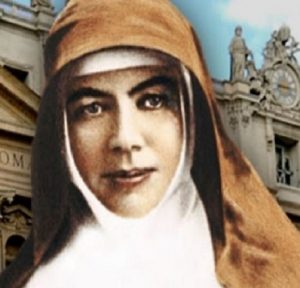 Reflection
Reflection
- Our current way of living offers a smorgasbord of technology. Mary MacKillop fostered personal connections in a limited way. How are we using our devices to remember our family members and friends particularly those suffering illness or hardship?
- Humour and surprise were important to Mary MacKillop. How can we bring joy to others in everyday life in simple ways?
- Let us be grateful for the gift of Mary.
Michele Shipperley rsj
Canonisation of St Mary MacKillop
October 17, 2020In Search of a Miracle.
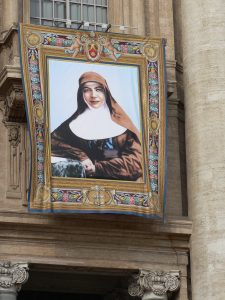 A significant requirement for a canonisation is the attribution of a miracle to the intercession of the person to be canonised. Saint Mary of the Cross was beatified by Pope John Paul II at Randwick Racecourse on 19 January, 1995. She was, by that proclamation, a saint for Australia. The next step was to seek her canonisation, a step that would recognise her as a saint for the universal church. This process required proof of her intercession by the recognition of another miracle which was needed to take place after the beatification.
A significant requirement for a canonisation is the attribution of a miracle to the intercession of the person to be canonised. Saint Mary of the Cross was beatified by Pope John Paul II at Randwick Racecourse on 19 January, 1995. She was, by that proclamation, a saint for Australia. The next step was to seek her canonisation, a step that would recognise her as a saint for the universal church. This process required proof of her intercession by the recognition of another miracle which was needed to take place after the beatification.
In 2001 I was appointed vice-postulator to Fr Paul Gardiner sj who was the Postulator since 1984. One of the tasks was to find a cure that would meet the stringent requirements to be considered for study as a miracle. Sr Claire Burgess and her assistants worked assiduously responding to requests for prayer for those in need. Claire had mountains of papers outlining remarkable cures but, for one reason or another, none met all the documentary requirements until one crossed her desk in 2005 relating to an extraordinary cure of Mrs Kathleen Evans. I visited Kath and her husband, Barry, at their home on 17 October, 2005. Barry as well as Kath’s doctors had kept copies of her medical records and were willing to share them. They were invaluable to the study for the miracle.
After my visit to Kath and Barry I wondered why I had not seen this case before. I was in bed and had a lightbulb moment – I realised that the cure had occurred after the Decree of Beatification was promulgated but before the ceremony was held. I got out of bed and called an official, Monsignor Robert Sarno, whom we had met some years previously as students from Ottawa visiting the Causes of Saints Dicastery. He informed me that the Bishop of Maitland – Newcastle was the person to write to the Prefect of the Causes of Saints asking for a dispensation of time. I drafted the letter which was duly sent by the Bishop early November and we looked forward to a good Christmas gift – the granting of the requested dispensation. It had not arrived by November 2007.
Mary MacKillop was a great believer in the Providence of God and Providence played a big part in the journey to canonisation. On 7 November, 2007 I was asked to attend lunch at Mary MacKillop Place with a group of overseas reporters preparing for World Youth Day 2008. One of the reporters asked how the Cause was progressing. I told him in rather strong terms of our disappointment with the non-reply from Rome to the request. When I finished, he informed me he was a close friend of the Prefect and he would visit him on his return. I was a bit mortified to say the least but thrilled (as were all who were waiting) to receive news of the requested dispensation in January 2008.
Thus, began the final two-year journey, a journey that had begun in 1925 when the Cause of Mary’s canonisation opened. Kathleen’s cure was declared a miracle through the intercession of Mary on 19 December, 2009. Mary of the Cross MacKillop was canonised in Rome, the first canonised saint for Australia and a saint for the universal Church, on 17 October, 2010 exactly five years to the day from my first meeting with Kathleen Evans. Kathleen (with Barry at her side) engaged in a wonderful ministry of making Mary MacKillop known and enjoyed good health for 23 more years – a wonderful miracle indeed.
Sr Maria Casey rsj
Associates to Companions – A New Chapter
As Mary MacKillop continues to inspire people today, the Associate movement which began over thirty years ago, is now one of the four recognised pathways of sharing in the Josephite charism.
Today the movement has ‘taken fresh courage’ and steps forward into the future with a new name – ‘Josephite Companions’.
Please join us in the launch of this new name, logo and prayer by viewing the following video…
